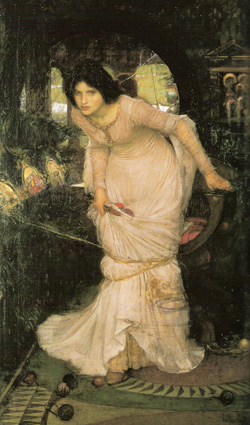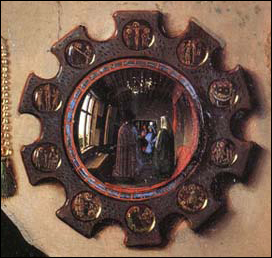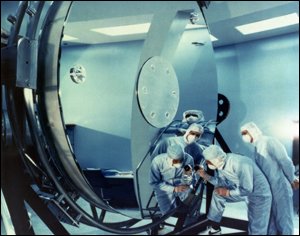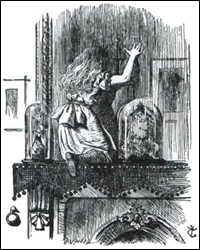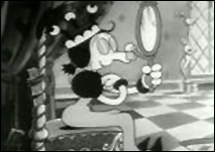7 Famous Mirrors (cont)
•3: Perseus’ Shield and the Gorgon.
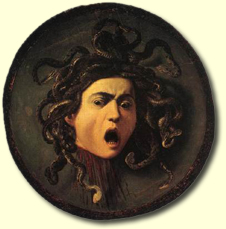
And while we’re on the subject of polished shields…
Imagine the Reverend as a young whippersnapper sitting in art class. The earnest teacher is holding up a print of Caravaggio’s Medusa and waxing rapturously about the wonderful ‘circular form’ of the composition. She holds this painting to be a perfect example of the ‘circular form’ and blah blah blah blah… the young Reverend’s attention wanders to a box kite that he can see floating off in the distance above the sports field.
It was some years afterward in Florence that the genius of Caravaggio (or someone else – read on…) revealed itself to me. I was wandering through the corridors of the Uffizi when I came upon the original painting of Medusa that I’d seen in school. But not on a flat canvas as I’d always assumed. As the myth goes, Perseus couldn’t look at Medusa directly lest he be turned immediately to stone. To this end, Caravaggio painted the severed head of the Gorgon as we know Perseus would have seen it – reflected in his polished shield, shrieking in outrage as it flies away from his flashing blade (and its former neck). Of course it’s a great example of circular form – because it’s actually painted on a real circular shield†, a detail that my teacher either didn’t know, or failed to pass on in her enthusiasm for Caravaggio’s technique.‡
She also neglected to tell the most interesting part of the story, a snippet that would have certainly regained the attention of the young Reverend because it concerned a personage with whom the young Reverend was most intrigued.
Caravaggio’s painting of Medusa is famous, but it’s not as widely known that there is said to have been a previous, and therefore more original, version of the exact same idea, executed by none other than Leonardo da Vinci.
The story of its existence is recorded by Giorgio Vasari, a 16th Century Italian architect and painter of moderate artistic accomplishments better known for his biographies of many other artists of his age. Among other things Vasari coined the term ‘Renaissance’ and wrote his Vita da Leonardo, a kind of Leonardo, This Is Your Life!
In the Vita, Vasari tells the story of a shield, or buckler, that was brought to Leonardo by his father for decoration. It appears that Leonardo was rather uncomplimentary about the workmanship of the shield, which was made by a peasant in his father’s service, but went on to make the best of a poor opportunity:
And afterwards, having given it a coat of gesso, and having prepared it in his own way, he began to think what he could paint upon it, that might be able to terrify all who should come upon it, producing the same effect as once did the head of Medusa.
Way to go Leo! He’s asked to decorate some homeware and chooses for a subject something designed to scare the shit out of viewers. Even as a young whippersnapper I knew that Leonardo da Vinci was my kind of guy.
The finished result, for which Leonardo derived inspiration from “…lizards great and small, crickets, serpents, butterflies, grasshoppers, bats, and other strange kinds of suchlike animals”, was, according to Vasari, so terrifying that Leonardo’s father, Ser Piero, was taken aback with fear “not thinking that it was the buckler, nor merely painted the form that he saw upon it…” but the real thing!
Ah, those were the days!
It is not known what happened to the Leonardo buckler. Most likely Leonardo’s mum took one look at it and said to Ser Piero: “You put that thing in the cellar! I won’t have it in the loungeroom scaring the bejeesus out of my whist club! Tut. I don’t know. Where did we go wrong with that boy?”
If indeed the Leonardo shield was ever anything more than an apocryphal invention Caravaggio would certainly have known about it. When he was commissioned to do a version by his patron, Cardinal Francesco Maria Del Monte, the unspoken challenge to the painter would have been – “C’mon, Mick, old son, let’s see you top Leo’s effort!”
___________________________________________________________________________
†In the Uffizi, the Caravaggio Medusa is displayed on a stand so that you can walk around it. It’s actually a real shield, although made of wood and not reflective brass (of course). The head is painted on the interior concave surface as Perseus would have had to have seen it, and is so masterfully done that it appears to be floating in space. It’s hard to convey the sense of delight that I had on realizing just what Caravaggio had done.
‡In my research for this piece I discovered that I’m not the only one who didn’t know that the Medusa is painted on a wooden shield. The method and medium is widely misunderstood to be ‘oil on canvas’.
___________________________________________________________________________
